Charles E W Bean, Diaries, AWM38 3DRL 606/273/1 - 1918 - 1937 - Part 12
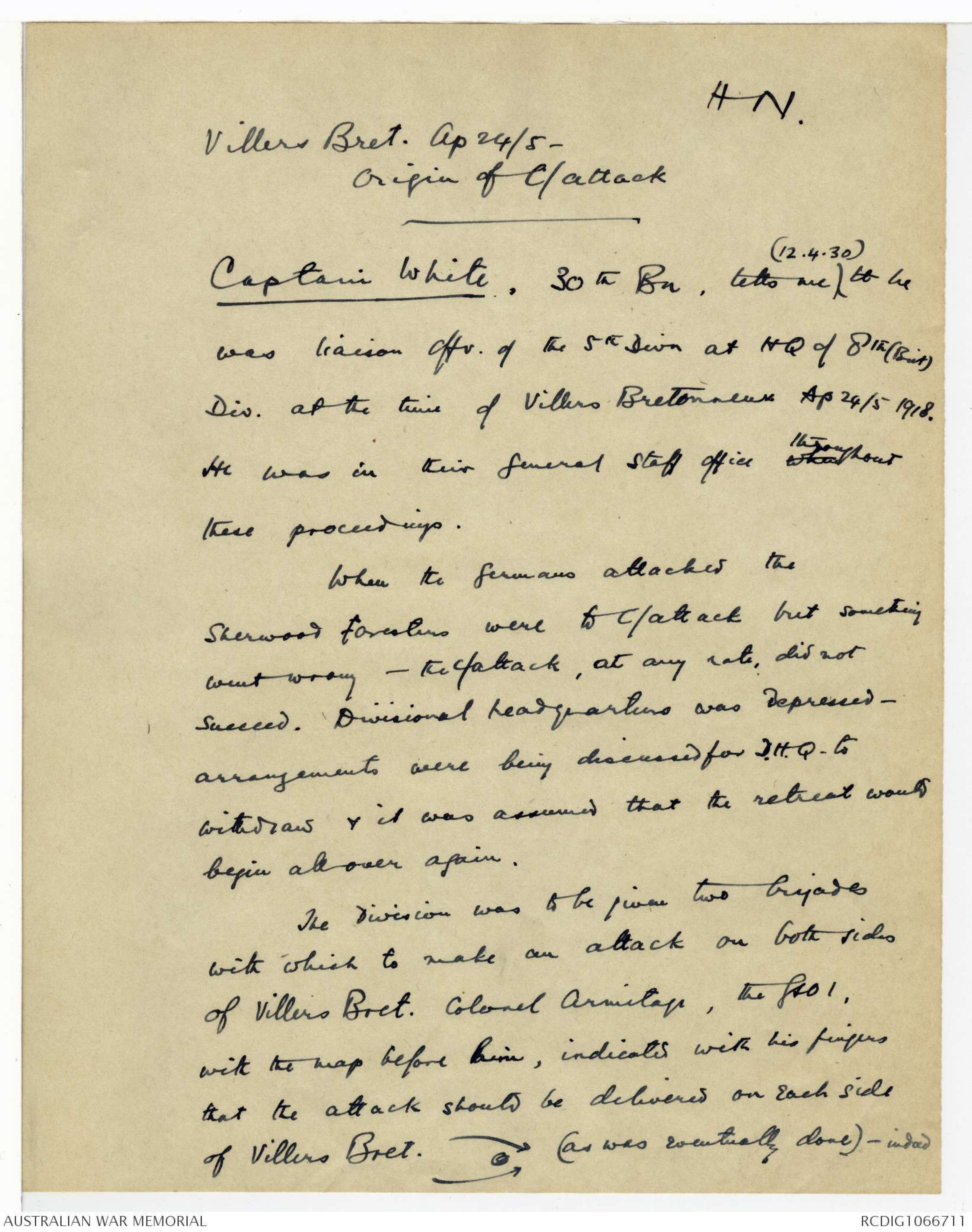
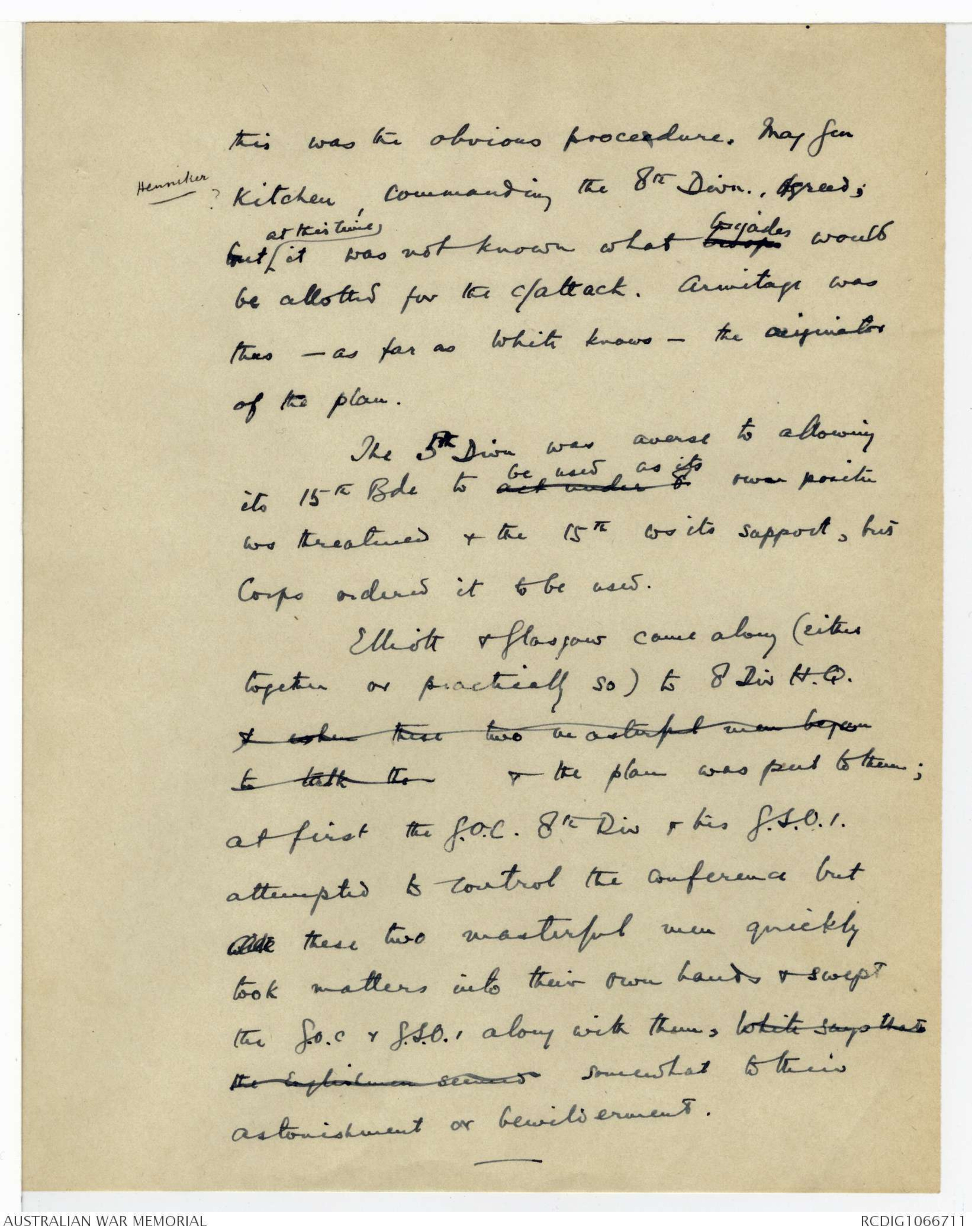
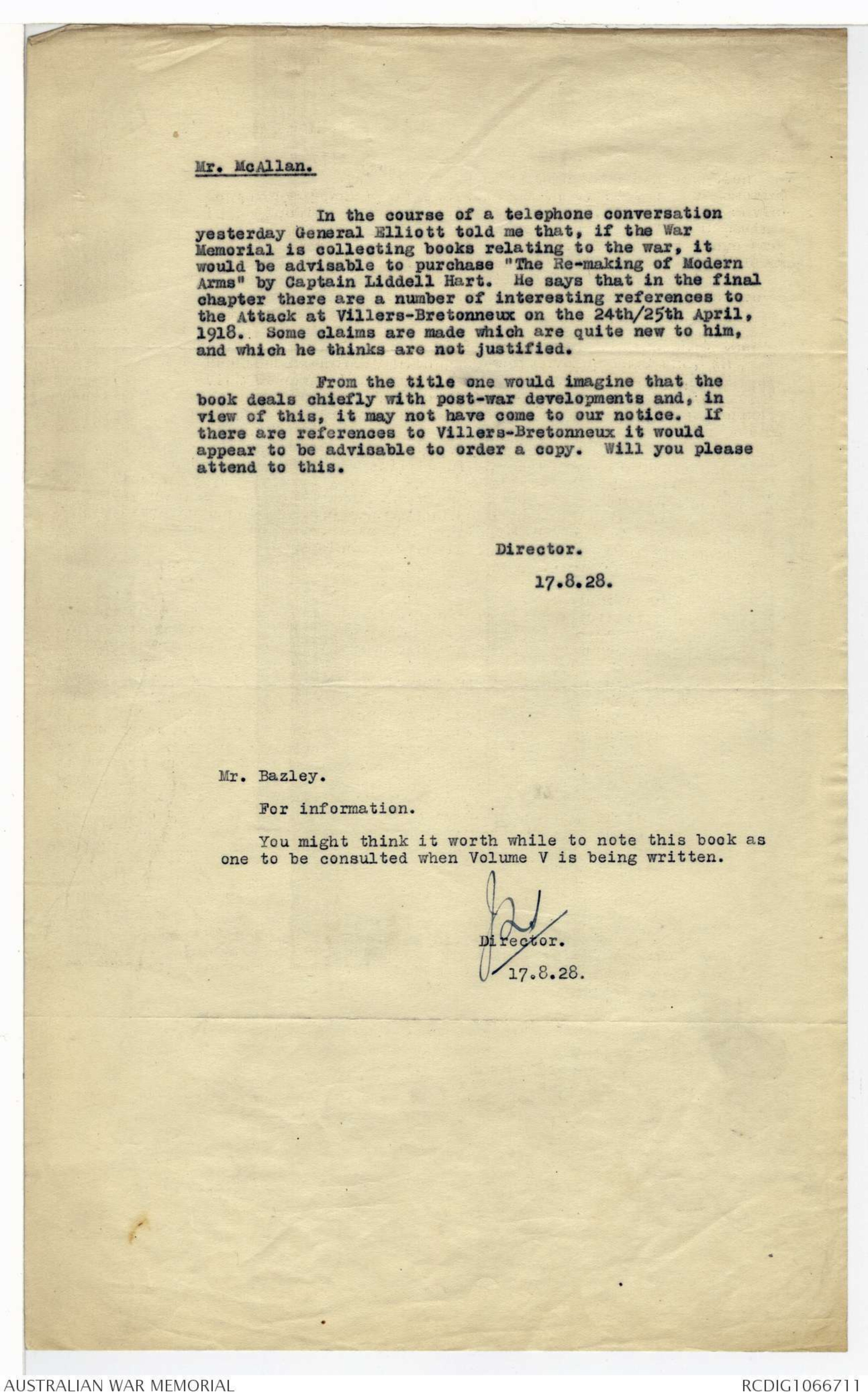

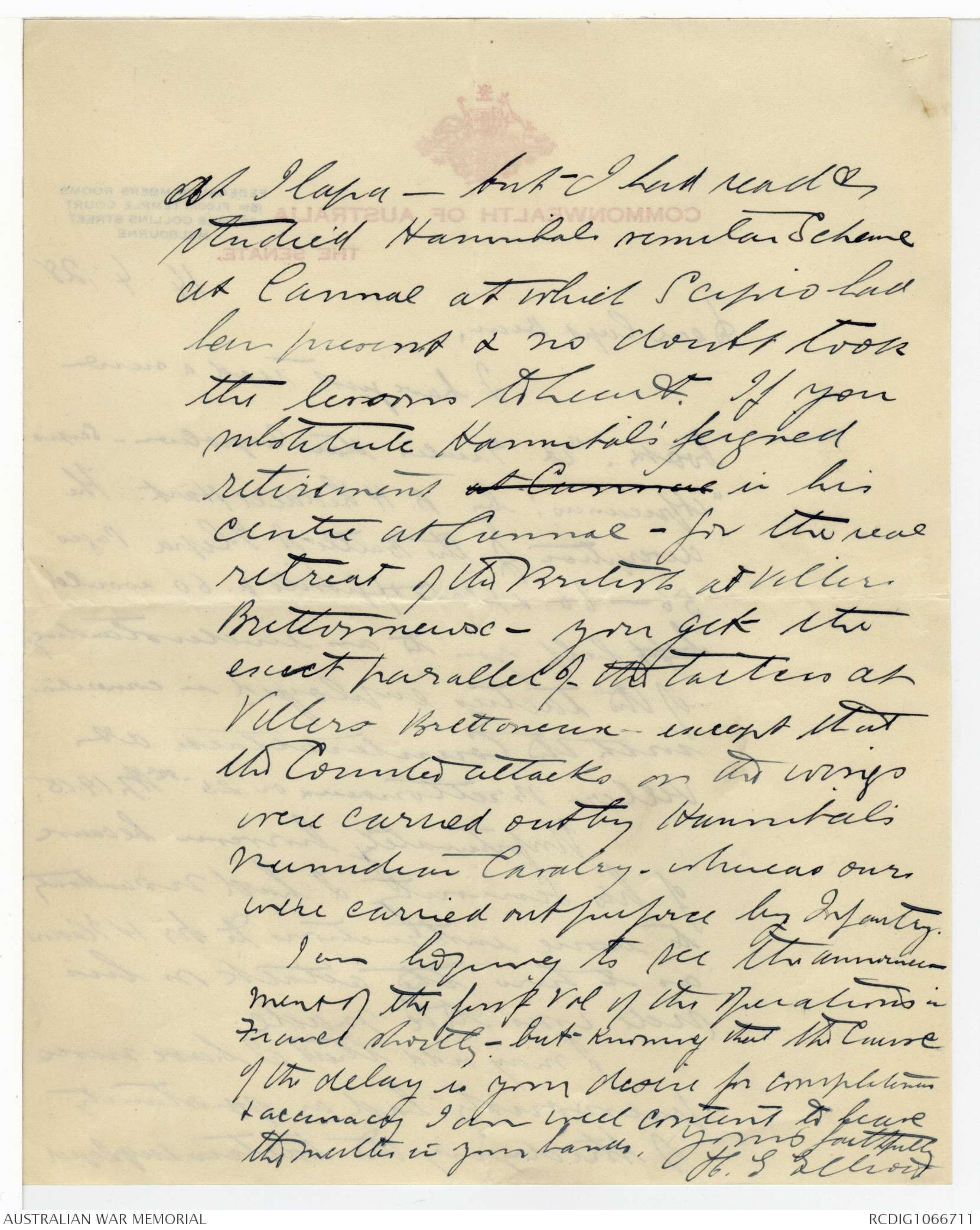
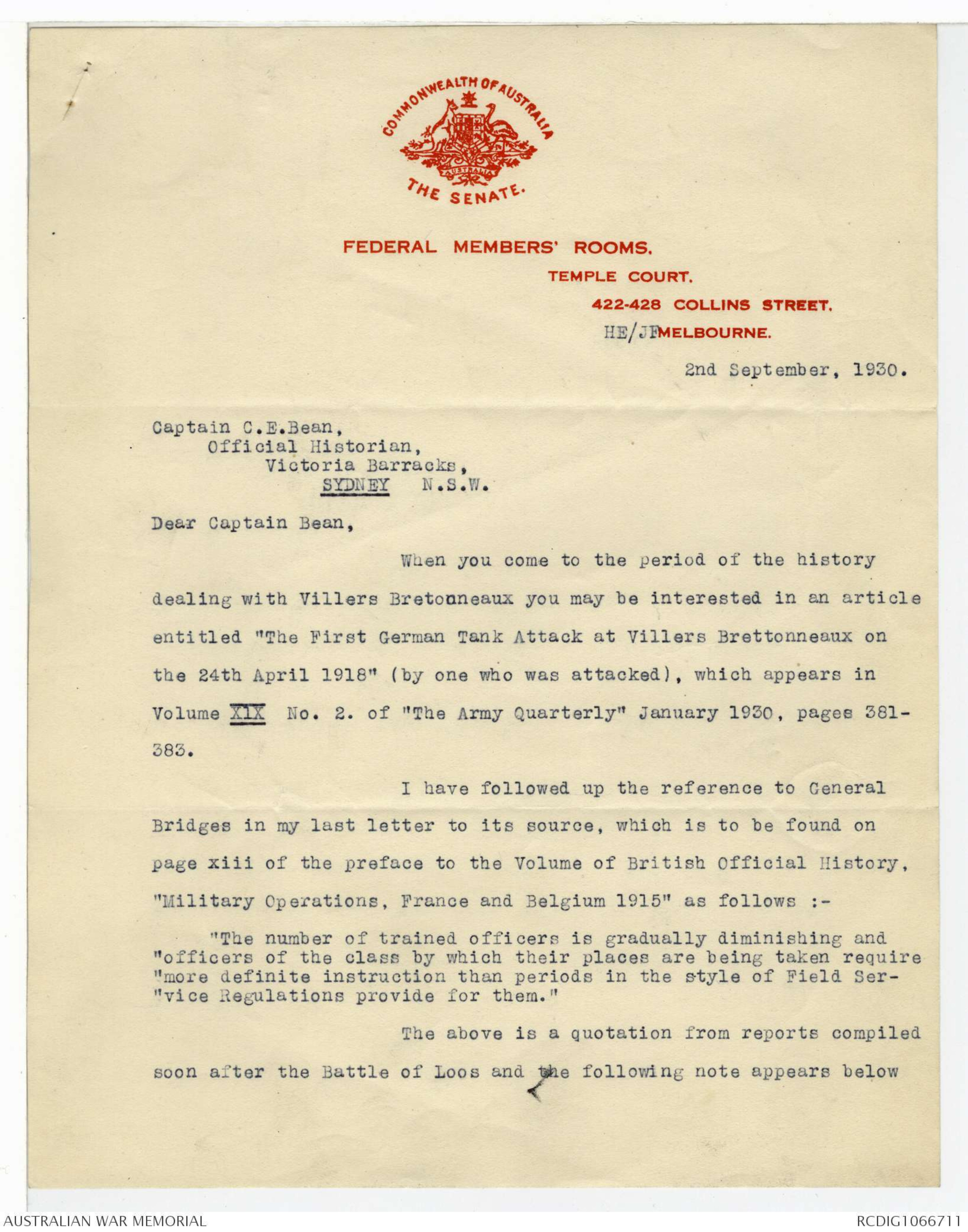
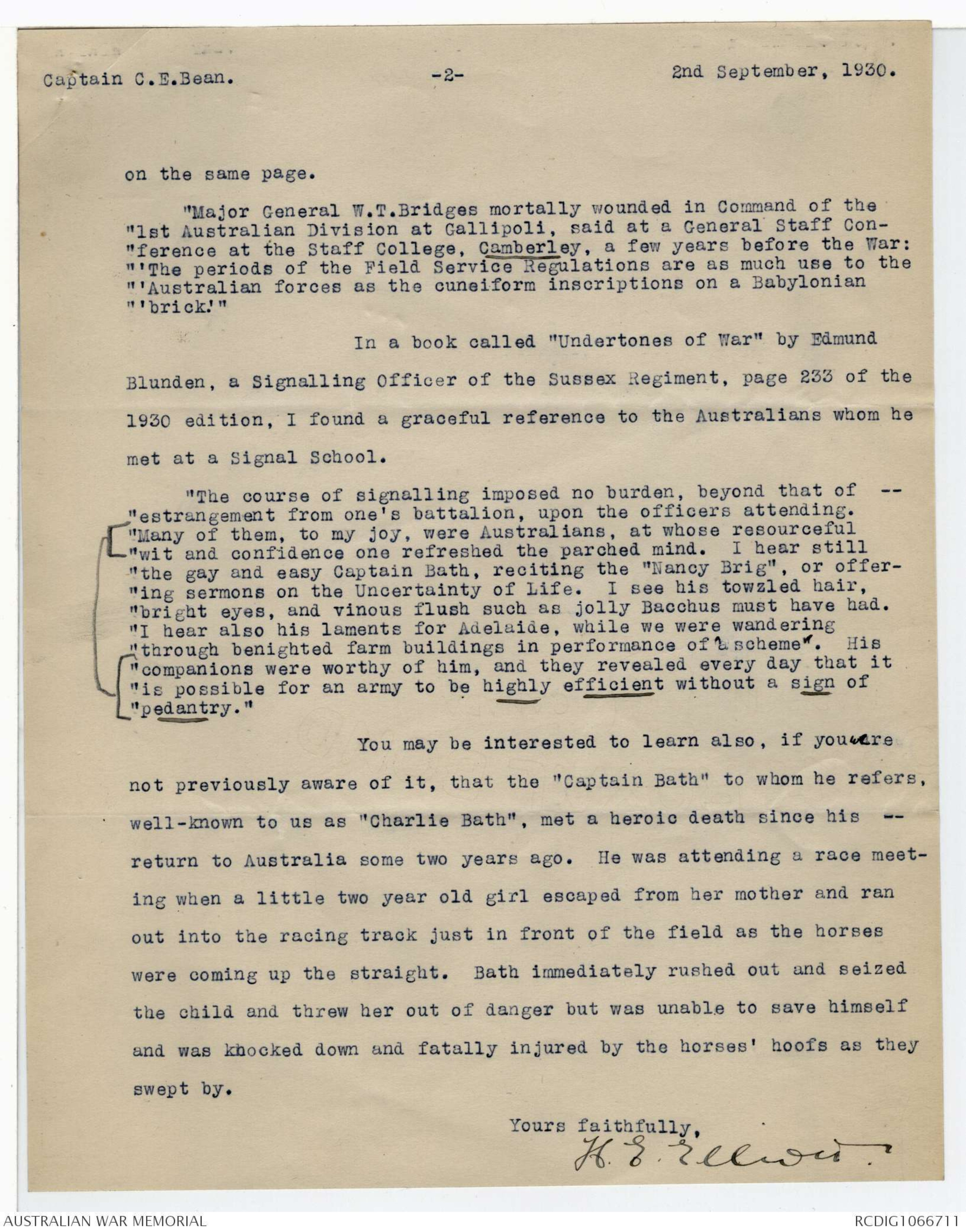
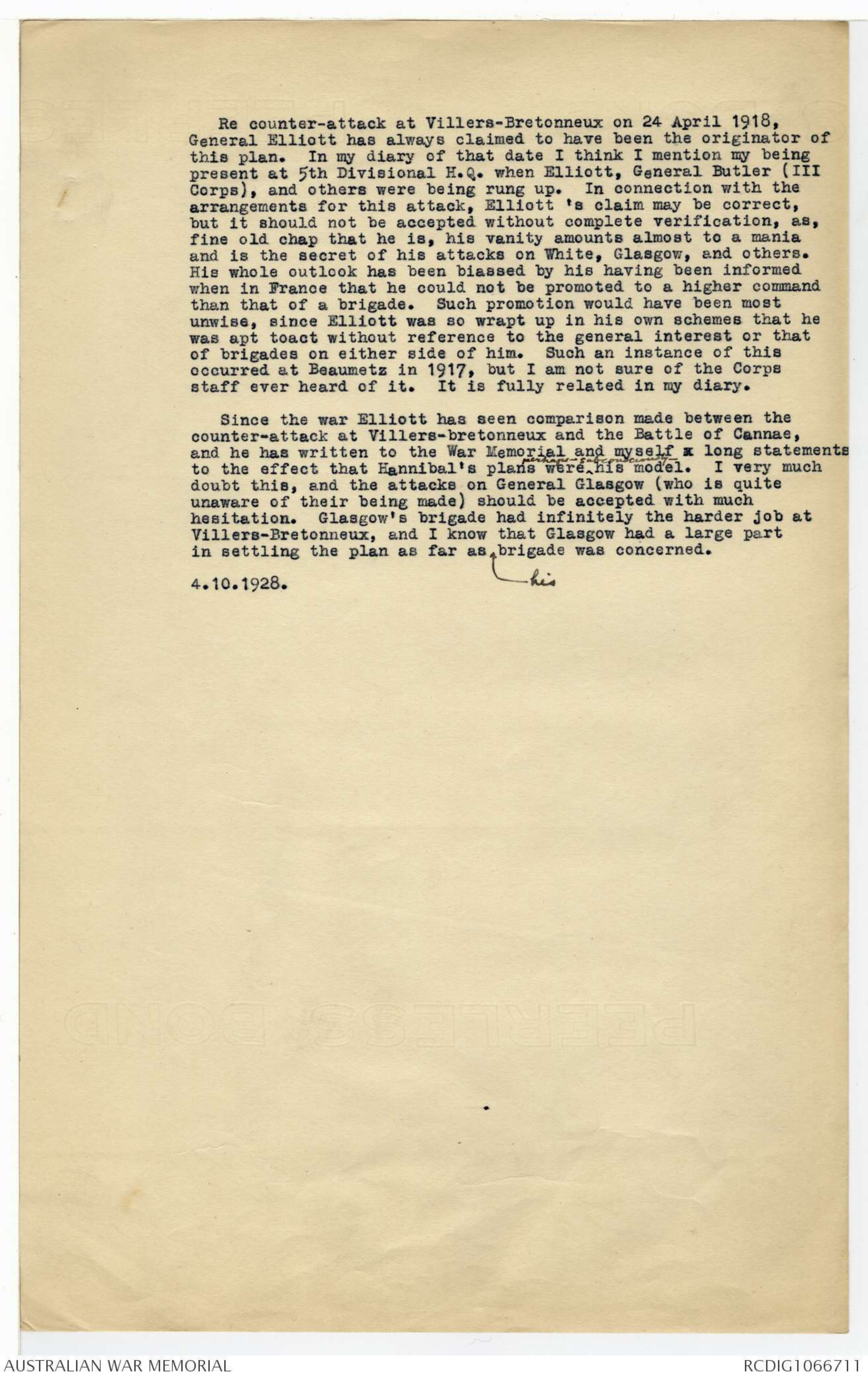
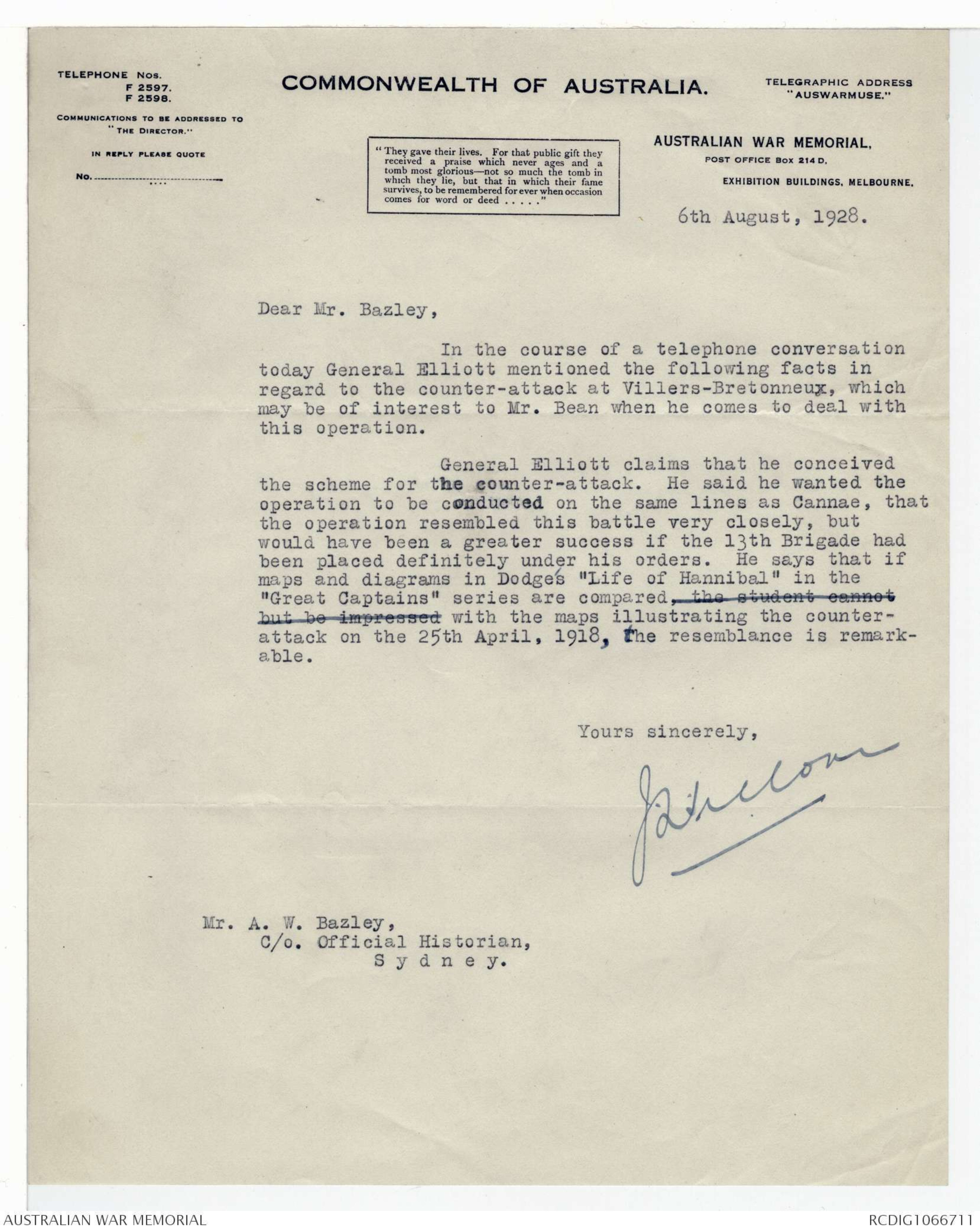
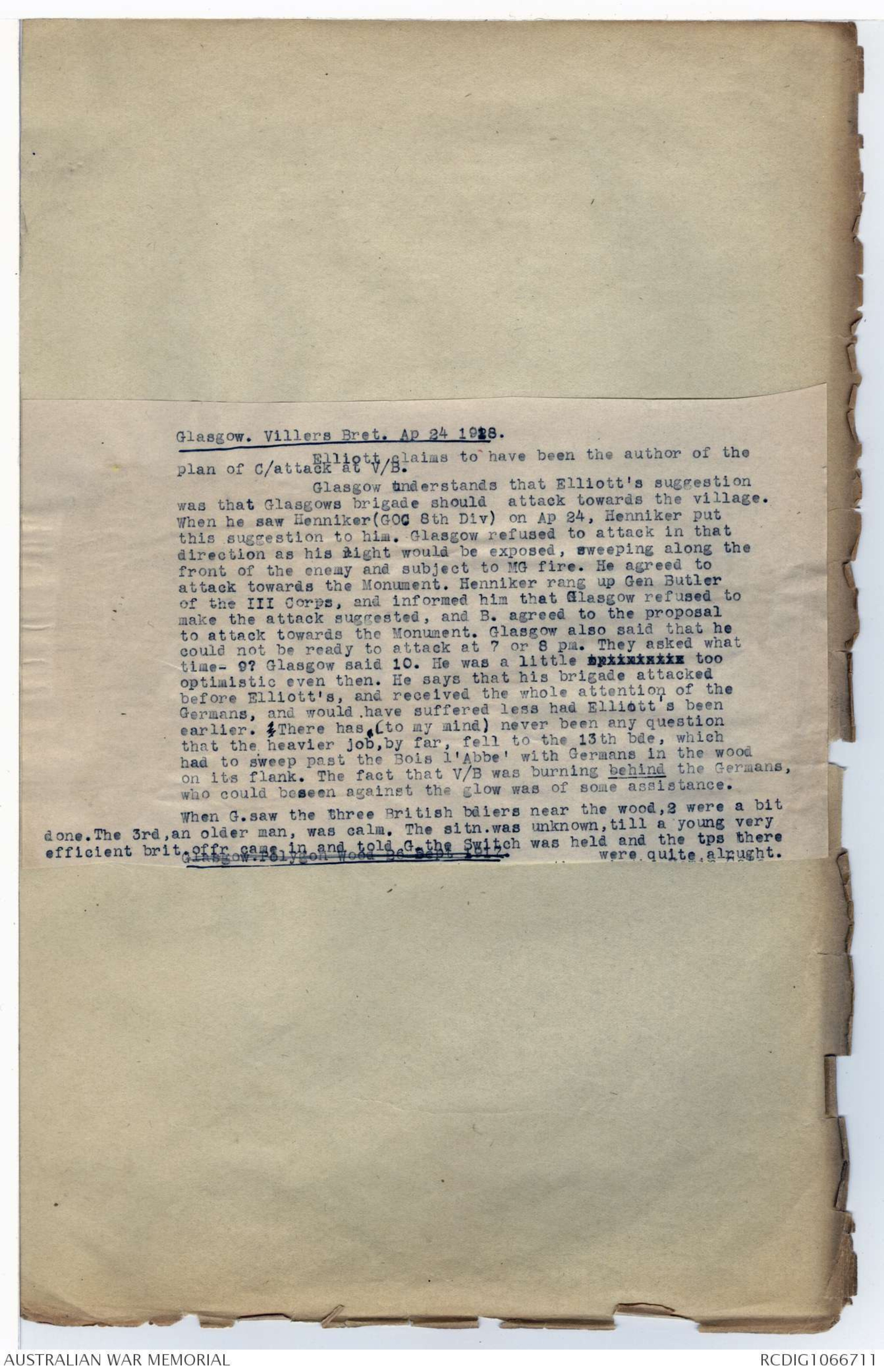
HN.
Villers Bret. Ap 24/5 -
Origin of C/attack
Captain White. 30th Bn, tells me ^(12.4.30) tt he
was liaison offr. of the 5th Divn at HQ of 8th (Brit)
Div. at the time of Villers Bretonneux Ap 24/5 1918.
He was in their general staff office when throughout
these proceedings.
When the Germans attacked the
Sherwood Foresters were to c/attack but something
went wrong - the c/attack, at any rate, did not
succeed. Divisional headquarters was depressed -
arrangements were being discussed for D.H.Q. to
withdraw & it was assumed that the retreat would
begin all over again.
The Division was to be given two brigades
with which to make an attack on both sides
of Villers Bret. Colonel Armitage, the GSO1,
with the map before him, indicated with his fingers
that the attack should be delivered on each side
of Villers Bret.
Diagram - see original document
(as was eventually done) - indeed
this was the obvious procedure. Maj Gen
[*Henniker?*] Kitchen, commanding the 8th Divn, agreed;
but ^at this time it was not known what troops brigades would
be allotted for the c/attack. Armitage was
thus - as far as White knows - the originator
of the plan.
The 5th Divn was averse to allowing
its 15th Bde to act under 8 be used as its own positn
ws threatened & the 15th ws its support, but
Corps ordered it to be used.
Elliott & Glasgow came along (either
together or practically so) to 8 Div H.Q.
& when these two masterful men began
to talk the & the plan was put to them;
at first the G.O.C. 8th Div & his G.S.O.1.
attempted to control the conference but
with these two masterful men quickly
took matters into their own hands & swept
the G.O.C. & G.S.O.1. along with them, White says that
the Englishmen seemed somewhat to their
astonishment or bewilderment.
Mr. McAllan.
In the course of a telephone conversation
yesterday General Elliott told me that, if the War
Memorial is collecting books relating to the war, it
would be advisable to purchase "The Re-making of Modern
Arms" by Captain Liddell Hart. He says that in the final
chapter there are a number of interesting references to
the Attack at Villers-Bretonneux on the 24th/25th April,
1918. Some claims are made which are quite new to him,
and which he thinks are not justified.
From the title one would imagine that the
book deals chiefly with post-war developments and, in
view of this, it may not have come to our notice. If
there are references to Villers-Bretonneux it would
appear to be advisable to order a copy. Will you please
attend to this.
Director.
17.8.28.
Mr. Bazley.
For information.
You might think it worth while to note this book as
one to be consulted when Volume V is being written.
JLT
Director.
17.8.28.
COMMONWEALTH OF AUSTRALIA.
THE SENATE.
FEDERAL MEMBERS ROOMS
(5th FLOOR) TEMPLE COURT
422-428 COLLINS STREET
MELBOURNE
14.4.28
Dear Capt Bean,
I have just read a new
book. "A Greater than Napoleon - Scipio
"Africanus! by B. H. Liddell Hart. The
description of the Battle of Ilipa Pages
56 - 66 & plate opposite p. 60. would
hepl help. you to an understanding
of the tactics employed in connection
with the Counterattack at
Villers Brettonneux on 25th Ap 1918.
Unfortunately however because
of his seniority I had no authority
to issue instructions to Sir W. Havens
as to how the attack on his
side was to be made.
I may add that I have never
previously had an opportunity
of studying the tactics employed
at Ilapa - but I had read &
studied Hannibals similar scheme
at Cannae at which Scipio had
been present & no doubt took
the lessons to heart. If you
substitute Hannibal's feigned
retirement at Cannae in his
centre at Cannae - for the real
retreat of the British at Villers
Brettonneux - you get the
exact parallel of the tactics at
Villers Brettoneux - except that
the Counter attacks on the wings
were carried out by Hannibal's
Numidian Cavalry - whereas ours
were carried out perforce by Infantry.
I am hoping to see the announcement
of the first Vol of the operations in
France shortly - but - knowing that the Cause
of the delay is your desire for completeness
& accuracy I am well content to leave
the matter in your hands. Yours faithfully
H. E. Elliott
COMMONWEALTH OF AUSTRALIA
THE SENATE.
FEDERAL MEMBERS' ROOMS.
TEMPLE COURT.
422-428 COLLINS STREET.
MELBOURNE.
HE/JF
2nd September, 1930.
Captain C.E.Bean,
Official Historian,
Victoria Barracks,
SYDNEY N.S.W.
Dear Captain Bean,
When you come to the period of the history
dealing with Villers Bretonneaux you may be interested in an article
entitled "The First German Tank Attack at Villers Brettonneaux on
the 24th April 1918" (by one who was attacked), which appears in
Volume XIX No. 2. of "The Army Quarterly" January 1930, pages 381-383.
I have followed up the reference to General
Bridges in my last letter to its source, which is to be found on
page xiii of the preface to the Volume of British Official History.
"Military Operations, France and Belgium 1915" as follows :-
"The number of trained officers is gradually diminishing and
"officers of the class by which their places are being taken require
"more definite instruction than periods in the style of Field Service
"Regulations provide for them."
The above is a quotation from reports compiled
soon after the Battle of Loos and the following note appears below
-2-
Captain C. E. Bean
2nd September, 1930.
on the same page.
"Major General W.T. Bridges mortally wounded in Command of the
"1st Australian Division at Gallipoli, said at a General Staff Conference
"at the Staff College, Camberley, a few years before the War:
"'The periods of the Field Service Regulations are as much use to the
"'Australian forces as the cuneiform inscriptions on a Babylonian
"'brick.' "
In a book called "Undertones of War" by Edmund
Blunden, a Signalling Officer of the Sussex Regiment, page 233 of the
1930 edition, I found a graceful reference to the Australians whom he
met at a Signal School.
"The course of signalling imposed no burden, beyond that of --
"estrangement from one's battalion, upon the officers attending.
["Many of them, to my joy, were Australians, at whose resourceful
["wit and confidence one refreshed the parched mind. I hear still
"the gay and easy Captain Bath, reciting the "Nancy Brig". or offering
"sermons on the Uncertainty of Life. I see his towzled hair,
"bright eyes, and vinous flush such as jolly Bacchus must have had.
"I hear also his laments for Adelaide, while we were wandering
"through benighted farm buildings in performance of "a scheme". His
["companions were worthy of him, and they revealed every day that it
["is possible for an army to be highly efficient without a sign of
["pedantry."
You may be interested to learn also, if you were
not previously aware of it, that the "Captain Bath" to whom he refers,
well-known to us as "Charlie Bath", met a heroic death since his --
return to Australia some two years ago. He was attending a race meeting
when a little two year old girl escaped from her mother and ran
out into the racing track just in front of the field as the horses
were coming up the straight. Bath immediately rushed out and seized
the child and threw her out of danger but was unable to save himself
and was knocked down and fatally injured by the horses' hoofs as they
swept by.
Yours faithfully,
H.E. Elliott
Re counter-attack at Villers-Bretonneux on 24 April 1918,
General Elliott has always claimed to have been the originator of
this plan. In my diary of that date I think I mention my being
present at 5th Divisional H.Q. when Elliott, General Butler (III
Corps), and others were being rung up. In connection with the
arrangements for this attack, Elliott's claim may be correct,
but it should not be accepted without complete verification, as,
fine old chap that he is, his vanity amounts almost to a mania
and is the secret of his attacks on White, Glasgow, and others.
His whole outlook has been biassed by his having been informed
when in France that he could not be promoted to a higher command
than that of a brigade. Such promotion would have been most
unwise, since Elliott was so wrapt up in his own schemes that he
was apt to act without reference to the general interest or that
of brigades on either side of him. Such an instance of this
occurred at Beaumetz in 1917, but I am not sure of the Corps
staff ever heard of it. It is fully related in my diary.
Since the war Elliott has seen comparison made between the
counter-attack at Villers-bretonneux and the Battle of Cannae,
and he has written to the War Memorial and myself x long statements
to the effect that Hannibal's plans were ^perhaps subconsciously his model. I very much
doubt this, and the attacks on General Glasgow (who is quite
unaware of their being made) should be accepted with much
hesitation. Glasgow's brigade had infinitely the harder job at
Villers-Bretonneux, and I know that Glasgow had a large part
in settling the plan as far as ^his brigade was concerned.
4.10.1928.
6th August, 1928.
Dear Mr. Bazley,
In the course of a telephone conversation
today General Elliott mentioned the following facts in
regard to the counter-attack at Villers-Bretonneux, which
may be of interest to Mr. Bean when he comes to deal with
this operation.
General Elliott claims that he conceived
the scheme for the counter-attack. He said he wanted the
operation conducted on the same lines as Cannae, that
the operation resembled this battle very closely, but
would have been a greater success if the 13th Brigade had
been placed definitely under his orders. He says that if
maps and diagrams in Dodges "Life of Hannibal" in the
"Great Captains" series are compared, the student cannot
but be impressed with the maps illustrating the counter-attack
on the 25th April, 1918, the resemblance is remarkable.
Yours sincerely
JL Treloar
Mr. A. W. Bazley,
C/o Official Historian,
Sydney.
Glasgow. Villers Bret. Ap 24 1918.
Elliott claims to have been the author of the
plan of C/attack at V/B.
Glasgow understands that Elliott's suggestion
was that Glasgows brigade should attack towards the village.
When he saw Henniker (GOC 8th Div) on Ap 24, Henniker put
this suggestion to him. Glasgow refused to attack in that
direction as his right would be exposed, sweeping along the
front of the enemy and subject to MG fire. He agreed to
attack towards the Monument. Henniker rang up Gen Butler
of the III Corps, and informed him that Glasgow refused to
make the attack suggested, and B. agreed to the proposal
to attack towards the Monument. Glasgow also said that he
could not be ready to attack at 7 or 8 pm. They asked what
time - 9? Glasgow said 10. He was a little optimistic too
optimistic even then. He says that his brigade attacked
before Elliott's, and received the whole attention of the
Germans, and would have suffered less had Elliott's been
earlier. X There has, (to my mind) never been any question
that the heavier job, by far, fell to the 13th bde, which
had to sweep past the Bois l 'Abbe' with Germans in the wood
on its flank. The fact that V/B was burning behind the Germans,
who could be seen against the glow was of some assistance.
When G. saw the three British bdiers near the wood, 2 were a bit
done. The 3rd, an older man, was calm. The sitn. was unknown, till a young very
efficient brit. offr came in and told G. the Switch was held and the tps there
were quite alrught.
Glasgow.Polygon Wood B6 Sept 1917.
 Transcriber 6897
Transcriber 6897This transcription item is now locked to you for editing. To release the lock either Save your changes or Cancel.
This lock will be automatically released after 60 minutes of inactivity.